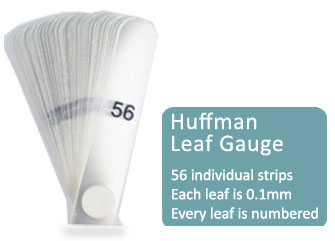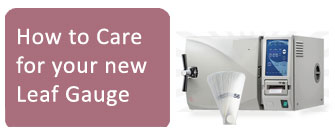How to Guide for Huffman Leaf Gauge
The Huffman Dental Leaf Gauge is a very simple device similar to a “feeler gauge” except all leaves are of the same dimension. Leaves may be of a mylar, polyester, polycarbonate, acetate, or other type of plastic material. Ideally they should bend freely without creasing and rebound to their original shape for reuse.

The History
Long introduced the leaf gauge in 1973, at which time he discussed its construction and use in the locating of centric relation and in adjusting occlusions. Williamson et al further elaborated its clinical applications in determining and recording centric relation. Regenos and myself have been teaching the use of the leaf gauge since the mid-seventies. Shankland and Ralston reported the use of the leaf gauge and our teaching philosophy in 1983. Golsen and Shaw reported how to make a leaf gauge along with its use in 1984. Rosenblum conceived the idea of numbering the leaves and reported a construction technique along with Huffman in 1985.
McHorris advocates the use of a leaf gauge by M.P.D.S. patients to cycle their muscle spasm symptoms. Regenos uses the leaf gauge exclusively when trying-in and seating castings. Huffman reported his cusp-fossae equilibration technique utilizing a numbered leaf gauge in 1987. Carroll et al reported on the use of an anterior jig or leaf gauge in routine clinical practice.
Step by Step how to use the Leaf Gauge
The leaf gauge is held by the dentist or assistant with “X” number of leaves placed into the oral cavity at the midline, resting on (and parallel to) the lingual surfaces of the maxillary central incisor teeth. The patient is instructed to close on his (or her) back teeth until a lower front tooth touches the underside of the leaves. “X” number of leaves is that number where the patient can just barely feel a posterior tooth touch (arrived at by the trial and error addition of leaves). With x+1 leaves the patient initially cannot feel any posterior tooth contact. However, as he or she holds their jaw closed (with only half hard closing force) for approximately 15-20 seconds they will again be able to feel a posterior tooth contact. At this time the mandible is said to be tripodized in its centric relation position with the right and left condyles seated in their true, respective glenoid fossae housings with only a lower incisor tooth making contact on the under side of the leaves.
This eliminates potential operator guided errors in centric relation by permitting the patients own neuromusculature to seat the condyles into their centric relation positions. The average is approximately X+6 leaves to arrive at this finalized position with a normal range of X+2 to X+9 leaves.
Occlusal Equilibration and Adjusting Castings
If you are using the leaf gauge for an occlusal equilibration or to adjust castings to centric relation occlusion you start with the finalized X+? number of leaves. Gradually remove leaves one at a time, marking the prematurity each time with mylar tape such as Acufilm II or MDSII and making the necessary adjustments as each leaf is removed.
When utilizing the leaf gauge to make centric relation interocclusal records for mounting diagnostic casts, the operator starts with the finalized X+? leaves and arbitrarily adds 3 or 4 additional leaves as a “fudge” factor so the teeth cannot close completely through the recording material (which would result in an inaccurate record). An anterior cut-out is made in the recording wax or the framework to house the leaves. The recording material is positioned onto the maxillary arch of teeth, the leaf gauge properly inserted and the patient instructed to close as befor until the lower front tooth touches the leaf gauge; gently but firmly hold the mandible in this position until the recording material chills or sets, as the case may be. We recommend cloth reinforced Aluwax bite wafers for the recording material for centric relation interocclusal records to mount diagnostic casts (master treatment casts require more accurate materials); however, you may use the recording material of your choice as long as a voided space is provided for the placement of the leaves.
I suggest you consult Dr. McHorris for leaf gauge utilization for the physical therapy technique to cycle painful muscle spasm. At: 3100 Walnut Grove, #302; Memphis, TN 38111
This numbered leaf gauge permits easy recording of the exact number of leaves. Also, since the leaves are almost exactly 0.1mmthick it gives the operator a very rapid reading of the exact opening in mm’s (eg. 5 leaves equals 0.5mm opening).
CAUTION: It has been reported in the literature that if the patient is permitted to close with maximum closing force on the leaf gauge it is possible to displace the mandible slightly inferior and posterior. This has never been a problem since we merely caution the patient to close only about half as hard as they can.

Sterilization and Cleaning
Use Autoclave to sterilize the Leaf Gauge. Note: only Leaf Gauges with the clear post can be run through Autoclave.
Type 1 |
|
|---|---|
| Method |
Moist heat sterilization |
| Cycle |
Pre-Vacuum (Pre-Vac), wrapped |
| Temperature |
270* F (132* C) |
| Exposure Time |
4 minutes |
| Pressure |
2-15 minutes |
| Drying Time |
Recommended: 30 minutes (minimum, in chamber) |
| Cool Time |
60 minutes (minimum, at room temperature) |
Type 2 |
|
|---|---|
| Method |
Moist heat sterilization |
| Cycle |
Gravity, wrapped |
| Temperature |
250-277* F (132-137* C) |
| Exposure Time |
4 minutes |
| Drying Time |
Recommended: 30 minutes (minimum, in chamber) |
Storage of Instruments:
Please store medical devices in the sterilization packaging, in a dry and dust-free place. The shelf life is depending on the sterile barrier employed, storage manner, environmental and handling conditions. A maximum shelf life for sterilized medical devices before use should be defined by each health care facility.
The life of your Leaf Gauge
The gauge will last through many uses and the disinfection process. The exact number of uses is indeterminable due to the differences in users and uses.
One Year Warranty
Every unit is inspected before shipment. Your Huffman Numbered Leaf Gauge comes with a 1 year warranty against defects. Visit our Customer Service page for more information.

Articles
A Clincal Protocol for the Romoval of Balancing Interferences by Cherilyn G. Sheets, DDS | Jacinthe M. Paquette, DDS, FACP | Jean C. Wu, DDS | James F. Otten, DDS, FACD Oct 2015 issue of Inside Dentistry. net magazine available on line.
Simple Applcation of Anterior Jig or Leaf Gauge in Routine Clinical Practice. by W. J. Carroll, D.D.S., J.B. Woelfel,D.D.S., and R.W. Huffman, D.D.S. in May 1988 in The Journal of Prosthetic Dentistry availiable for purchase.
Additional Online Articles
1.Long, J.H.; Locating centric relation with a leaf gauge. J. Prosthet. Dent. 29:608-610, 1973.
2. Williamson, E.H., Steinke, R.M., Morse, P.K. and Swift, T.R.: Centric Relation comparison of muscle-determined position and operator guidance. Am. J. Orthod. 77:133-144, 1980.
3. Shankland, W.E., Ralston, S.J.: The fabrication and use of a leaf gauge to locate centric relation. Ohio Dent. J. 57: 43-45, 1983
4. Golsen, L. F., Shaw, A. F.: Use of leaf gauge in occlusal diagnosis and therapy. Quintessence Int.: #6 611-621, June 1984.
5. Huffman, R. W.: A cusp-fossae equilibration technique using a numbered leaf gauge. J. of Gnathology, Vol. 6, #1, 23-36, 1987.
6. Regenos, J. W., Huffman, R.W.: lecture notes, continuing education course. Gnathological Occlusion and Oral Rehabilitation, Ohio State University 1976-1986.
7. McHorris, W.H.: Personal Communication O.S.U. Cont. Educ. Course, May 1984.
8. Rosenblum, R.H., Huffman, R.W.: Leaf gauge with consecutively numbered leaves. J. Prosthet. Dent. 54 # 5, 652-654 Nov., 1985.
